
A study shows that French wine consumption has dropped over the course of two generations by three billion bottles per year. The study - spotlighted in The Telegraph - has some people concerned that the entire culture of wine in France may be on its way out.
Younger generations seem to be less likely to enjoy wine with a meal, and more inclined to drink wine for pleasure on a night out.
One figure I found hard to believe: only 16.5% of the French population are regular wine drinkers. The under-30 crowd, according to the researchers, views wine as a “sometimes” treat, not an everyday staple like their elder countrymen.
One researcher stated, “The younger generations may still take pride in French wine but have little awareness of its cultural place in French history.”
The study concludes that the loss of identity of wine as a national tradition is mainly to blame for the sharp decline in France’s wine consumption numbers over the past three generations. French consumption of wine has dropped to four billion bottles per year. That’s about 1 bottle per week for each adult.
In southeast Texas - where I grew up - and in southwest Louisiana, this same sort of identity loss has caused some to fear that the Cajun culture may be dying out. Many of my friends, and others our age, grew up in households where Cajun French was spoken regularly. With each passing generation, some of that Cajun identity has been lost as the younger folks are “Americanized.”
It’s hard to imagine a world where France isn’t synonymous with wine. Perhaps the cultural pendulum will soon start swinging the other way, into a rediscovery of wine in the nation for which it may have meant the most.
Follow Randy Fuller on Twitter.

Napa Valley's Cornerstone Cellars - as we have reported before on Now And Zin - has broadened their base. Already known for their exquisite line of Cornerstone wines, they now have a line of more moderately-priced wines designed for everyday consumption.
Cornerstone provided me with a sample of their Stepping Stone White Rocks! wine. Inspired by the blends of southern France, the Rocks! line takes a wine-of-the-vintage approach. The varieties and percentages used each year probably will change depending on what the vineyards deliver.
They say, "we want to offer blends without boundaries that will excite and please the occasional as well as the day to day wine drinker." Both the Stepping Stone and the Rocks! lines are intended to be thought of as house wines for serious wine people. The White Rocks! blend is certainly priced for everyday use, at $15.
Stepping Stone White Rocks! is a blend of Chardonnay and Muscat, which is immediately interesting upon lifting the glass to my nose. Aromas of minerals, lemon peel, hints of banana and apricot all play in the bouquet. The wine smells fresh and inviting.
On the palate, citrus and zest are carried along on a blast of acidity with a refreshing minerality. There’s some wood on the palate and a little bit of a spicy, peppery feel. The mouthfeel is slightly oily and medium in weight. Lime lingers on the finish.
Follow Randy Fuller on Twitter.

Wine Goes To The Movies
with NowAndZin.com & TrailersFromHell.com
Yeah, I know - wine isn’t exactly the mood modifier that comes to mind when thinking of "Woodstock." That's not to say it doesn’t fit, but other, stronger, more mind-liberating substances always seem to be the accompaniment of choice for this film - or so I hear. Like those who attended the Woodstock festival, viewers often prefer to feed their heads, not their palates.
Whatever you choose to serve at your viewing party, just make sure you have lots of it. In case you don't remember - and I hear that happens, too - the film is a smorgasbord of music that runs over three hours - longer if you opt for the additional footage in the Director's Cut.
The 1970 Academy Award winning documentary "Woodstock" creeps in on the moody intro of Crosby, Stills, Nash and Young's "Long Time Gone" and blazes out on the fade of their amped-up version of the Joni Mitchell paean to the rock festival to end all rock festivals. I remember hearing that David Crosby said Mitchell captured the essence of Woodstock better than anyone. That was quite a trick, since she took her manager's advice and skipped the three-day music orgy to appear on Dick Cavett instead.
In between "Fade in" and "Fade out," the movie crystallizes what was important about the decade for which it serves as the exclamation point. Here we are now, four decades further on, wearing nicer clothes and enjoying more expensive luxuries - with "Woodstock" to remind us of a time when we went up the country and drank wine straight from the bottle, and it was just fine.
"Don't eat the brown acid, man!" "Far out, man!" "It's a free concert, man!" Let's pick a wine that really rocks, man!
Malibu Estate Winery bottles a tasty blend called Purple Haze, with Syrah, Petite Sirah and Cabernet Franc co-starring in a juicy jam session. At $60 a bottle for the 2009 vintage, it makes the Netflix price increase seem inconsequential. Enjoy it with the Director’s Cut. I just hope you remember how good it is the morning after. I also hope you don’t wake up in the mud.
Other rockin’ wines:
Malibu Estate Winery’s Woodstock Collection offers a whole range of Woodstock wines, most priced more modestly than Purple Haze.
Wines That Rock has Woodstock Chardonnay, Forty Licks Merlot, Dark Side of the Moon Cab and Synchronicity, all with album cover labels.
Arlo’s Apple Wine - From a place called Rasta Ranch Vineyard on New York’s Seneca Lake.
Follow Randy Fuller on Twitter.
Follow Trailers From Hell on Twitter.
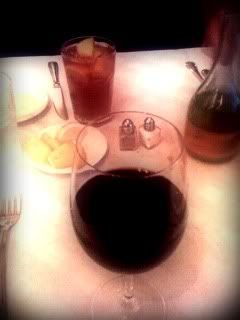
Drink Italian wine with Italian food. To do otherwise just doesn't seem right. I did mix up the regions a bit on this trip to the Beverly Hills ristorante, Il Buco, but I think it worked out fine.
The Cusumano Nero d'Avola from Sicily is $8 by the glass and I see it selling for around $12 by the bottle online.
Nero d'Avola is the main grape in the town of Avola in the southern part of Sicily. New-world comparisons are often made, but nothing really tastes like it in my book.
Cusumano's Nero d'Avola is a 100% varietal wine, of course. It's color is a very dark red, with hardly any light coming through. The nose is very dark, too, with notes of tar, roasted meat and forest floor. A beautiful palate shows blackberry, figs, anise and a touch of clove. The lengthy finish leaves hint of licorice and cola.
I paired the wine with risotto Milanese with Italian sausage. It probably wasn't the perfect match for the rice, but the sausage hit the right notes.
Follow Randy Fuller on Twitter.
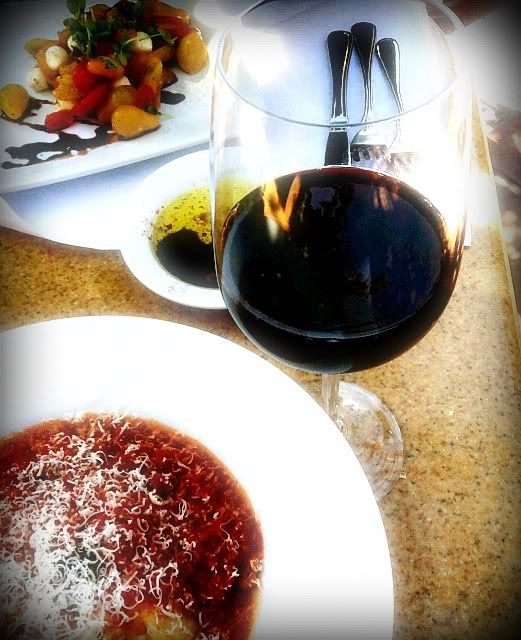
When we go to Disneyland, my wife and I often make California Adventure our first stop. If it's time for lunch, we head for Wine Country Trattoria at the Golden Vine Winery.
For the uninitiated, they actually grow grapes right there in the theme park. It's a real vineyard in the same sense that Disneyland's Frontierland is actually the Old West. But it does make me think of Napa Valley, which is the intent.
A site called All Ears - guess who's ears - has an interesting tidbit to share:
"Anaheim was actually a grape-growing area with a number of vineyards. But in the 1880s a virus called "Anaheim Disease" destroyed the grapevines, and the growers eventually turned to citrus instead. This virus still persists, and the vines at the Golden Vine Winery have to be re-planted as they fall prey to it."
The restaurant features nice Italian food and, of course, wine. The outside area makes a great place to dine and offers a good view of the World Of Color water and light spectacular in the evening. They say reservations are a must if you want that vantage point.
The Wine Country Trattoria's wine list has some nice Italian offerings in addition to the expected California pours. I usually pick a California wine, what with Mickey's smiling face looking down from the ferris wheel in the midway. This time, I chose an Italian vino.
The wine, Uve D'oro Nero d'Avola, is from Cantine Russo. The 2005 Sicilian red hails from vineyards in Sambuca di Sicilia and has an alcohol level of 12.5% abv.
The dark purple color suggests some rich flavor, and the nose gives it away with black fruit spiced with anise and clove. On the palate, the flavor of black tea layers over the dark fruit. It's a very aromatic wine and it tastes simply and rustically beautiful.
While I enjoyed it with the lasagna I ordered, I found myself wishing I had opted for a Sangiovese instead. I especially like the way Sangiovese pairs with tomato-based food, but this Nero was certainly serviceable. My wife liked the pairing more than I did, and I have the utmost respect for her sensibilities in pairing flavors.
Follow Randy Fuller on Twitter.

If you are dining out in a restaurant and you have questions about some of the offerings on a wine list, most places will offer to pour a taste to help you make up your mind.
I can usually make my way around a wine list without too much help, but there are times when I like a little assistance. Recently, at Sushiya On Sunset, I felt like a Chardonnay. The by-the-glass list offered two, the Sanford Santa Barbara County and the Talus Lodi Chardonnay. I was looking for a Chardonnay that was crisp and refreshing and somewhat light on the oak. I asked my server which one would be better.
Rather than guessing for me, she offered a taste of each so I could compare the two side by side. This helped me make up my mind in short order.
With both samples before me, I could easily see the Sanford was darker in color than the Talus. Right away, I surmised there would probably be more effect from the oak barrels in the Sanford. Tasting proved me right, with the Sanford showing a deliciously creamy, toasty vanilla profile while the Talus brought a leaner composition to the table, with more acidity than the Sanford.
My immediate needs called for the acidity of the Talus more than the lushness of the Sanford, so my choice was easy - thanks to the option of trying the two Chardonnays beforehand.
After the fact, I found that while the Sanford is 100% Chardonnay, the Talus is 91% Chardonnay and 9% Sauvignon Blanc. Had I known that beforehand, I probably would have simply opted for the Sauvignon Blanc blend. Since I didn't have this information at decision time, the offer to taste was quite appreciated and helpful.
By the way, the Talus Chardonnay paired perfectly with the freshwater eel and really brought out the flavor of the wasabi, too.
If you aren't sure about a wine selection in a restaurant, ask for a sample. They should be happy to pour a taste so you can be sure you'll like what you're buying.
Follow Randy Fuller on Twitter.
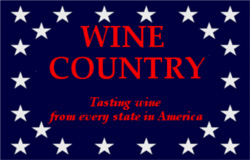
"Fine wine from the great Commonwealth of Kentucky." That's the banner on the Elk Creek Vineyards website, showing their pride in the wines grown and produced in the rolling hills near Owenton, about an hour from Lexington, Louisville and Cincinnati. What's more, they claim to be the largest winery in the state better known for bourbon and horses than wine.
The story of the wine industry in the Bluegrass State is an interesting one, and it goes back to the very beginning of the wine industry in America.
The Kentucky Wine website says Kentucky was "home to the first commercial vineyard in the United States, and once producer of more than half the nation's grape and wine output."
That first vineyard was in Lexington, on the Kentucky River. Swiss winemaker Jean-Jacques Dufour sailed over in 1798 to find new land for grape growing. He was the winemaker for the Marquis de Lafayette. Dufour bought 600 acres and dubbed it "The First Vineyard." According to Kentucky Wine, his first vintage in 1803 went to none other than Thomas Jefferson.
By the late 1800s, Kentucky was the third largest producer in America. Prohibition, of course, killed Kentucky's wine industry, and wineries weren't legal again until 1976! Now there are over 50 wineries in Kentucky.
Time and Prohibition took their toll in The First Vineyard, as it fell into oblivion. Reconstruction of that vineyard began in 2002. In 2008, 40 Cape grapevines were planted. They are said to be the grapes Dufour first planted there, and are also known by the name of Alexander. The present owners have since planted Riesling, Norton and Vignoles vines.
The great blog The Other 46 featured a nice video from Kentucky Wine, which I have borrowed here.
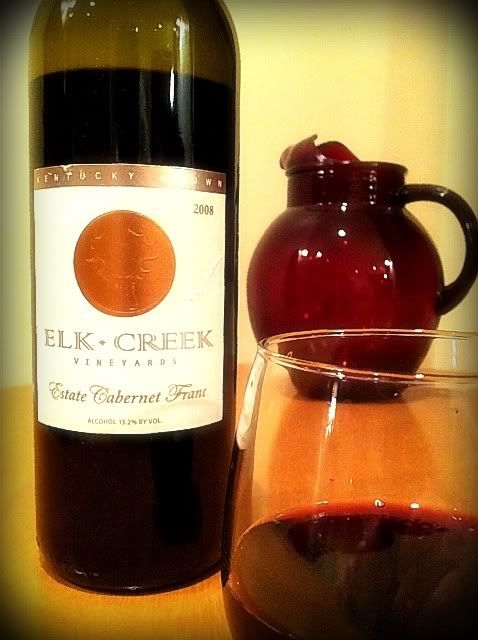 Elk Creek Vineyard's Estate Cabernet Franc 2008 is the second vintage of this wine from Elk Creek. Cab Franc is considered by the University of Kentucky to be difficult to grow and somewhat susceptible to cold weather
Elk Creek Vineyard's Estate Cabernet Franc 2008 is the second vintage of this wine from Elk Creek. Cab Franc is considered by the University of Kentucky to be difficult to grow and somewhat susceptible to cold weather
It says on the wine's label, "Kentucky Grown," and the folks at Elk Creek are quite proud of that. The wine has a most reasonable 13.2% alcohol content.
Medium ruby in color, Elk Creek's Cab Franc boasts a nose so fruity it’s almost perfumed. Extreme blueberry aromas, red plums, cassis, vanilla spice and a touch of cinnamon all compete for attention. Throw in a little pencil lead and you’d have a fine impersonation of a Napa Cab.
The taste seems a little hot at first, but after proper time to breathe it settles down very well. On the palate I find all that fruit my nose got acquainted with, plus a little trace of bell pepper. The green, or herbal notes really come forth on the finish, which is a lengthy and satisfying one.
After enjoying this great expression of Kentucky fruit, it's easy to see why Elk Creek Vineyards has so much pride in their heritage and their product.
Follow Randy Fuller on Twitter.

Wine Goes To The Movies
with NowAndZin.com and TrailersFromHell.com
It's easy to see, by browsing through the Trailers From Hell, there's a great love for movies that scare. One of the scariest is 1968's "Night of the Living Dead." This is no Sunday school picnic.
This is where the dead rise and walk among us. The mass hysteria caused by a zombie attack tops even the scariest doorbuster sale on Black Friday. There are some doors busted in this glorious black and white fright fest, but the only thing half off is your arm.
The movie gets some of its authentic creepiness from the Evans City Cemetery north of Pittsburgh, where some of it was shot. All in all, it's true what they say: nothing ruins a perfectly good Sunday like a zombie attack. Just listen to the bloodcurdling screams! How’d you like to have been at THAT foley session?
While on the subject of movie biz inside stuff, I understand the zombies eating bodies were actually eating roast ham covered in chocolate sauce. Chocolate sauce looks a lot like blood in black and white. A lot.
Before we lose our appetites completely, let's move on to the wine pairing.
What kind of wine does a decent, hard-workin’ zombie want after a full night’s work? All that trudging around like a slightly less animated Frankenstein, mutilating people and creating a general disturbance makes a zombie powerful thirsty.
This one is easy. Return Of The Living Red is the perfect wine for these slow-motion monsters.
The 2006 vintage of this Australian blood-red wine Is 70% Cabernet Sauvignon and 30% Touriga Nacional. That's a Portuguese grape, by the way, which at one time was also grown in Australia's McLaren Vale. Nearly all of those vines were ripped out, though, and Touriga Nacional became - at least for Australia - a dead grape.
You see where this is going, right? Redhead Studios brought the grape back to life and now it walks the earth among us - the Return Of The Living Red. The ancient vines which bore the grapes actually appear to be dead in some parts, they say, and the fruit is intensely concentrated.
Lavender and leather grace the nose, with currant and blackberry flavors, which I understand are favorites of zombies everywhere. In case you’re wondering, it pairs well with roast ham and chocolate sauce. There are only a few bottles left, mainly in the Chicago area. You’ll have to move faster than a zombie to get one.
And they don’t serve it at Beekman’s Diner.
Zombie Options:
d'Arenberg "The Dead Arm" Shiraz 2006, McLaren Vale, South Australia - $43
Midnight Sun "Mayhem" Belgian Double IPA, Alaska - $8
or, make a Zombie cocktail. Here's a tasty recipe.
Follow Randy Fuller on Twitter.
Follow Trailers From Hell on Twitter.

According to the Tom Petty song, "Free Fallin'," the vampires in the San Fernando Valley "move west down Ventura Boulevard." I don't know where they go from there, but if any vampires venture into Beverly Hills, I know a place where they can taste some wine.
The Vampire Lounge and Tasting Room isn't just a hangout for those with extended canine teeth. It's the retail embodiment of Vampire Vineyards, a winemaking outfit which draws grapes from Paso Robles, Santa Maria, Napa Valley and France's Loire Valley.
The business started in 1988 with the release of an Algerian Syrah, bottled in France. The first 500 bottles went to rock star Alice Cooper, and the rest is a history that's afraid of the daylight. The company's travels have gone through Italy and Transylvania itself. Now, the winemaking effort is based in Creston, California - a little bit southeast of Paso Robles.
Michael Machat is the founder and CEO of the company, and he plays a big part in the corporate backstory featured on the website. The Vampire Vineyards sommelier, Igor Fedenkov - really, it's on his business card - poured me through a sampling of the wines.
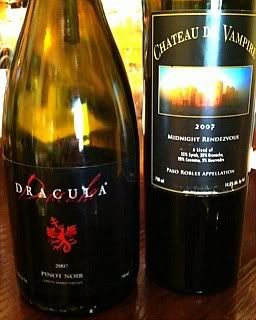 The Dracula Pinot Noir 2007 is made from Santa Maria grapes - picked before sunrise, of course. The wine spent 18 months in French oak. It has a big, rich nose and big, rich flavors to match. Cherry and raspberry notes dominate in properly dark fashion.
The Dracula Pinot Noir 2007 is made from Santa Maria grapes - picked before sunrise, of course. The wine spent 18 months in French oak. It has a big, rich nose and big, rich flavors to match. Cherry and raspberry notes dominate in properly dark fashion.
Chateau du Vampire Midnight Rendevous 2007 is a blend of Paso Robles Syrah, Grenache, Counoise and Mouvedre. There are bright cherry flavors in abundance and some great chocolate notes.
Trueblood Napa Valley Syrah 2004 is inky-dark enough to please any vampire who likes his wine smokey and spicy.
It's no surprise that red wines dominate the list, but Vampire Vineyards does offer a modest selection of whites - notably the Chateau du Vampire Roussanne of Paso Robles heritage - along with a White Zinfandel and the Je T'Aime Brut Rosé. Even vampires like to do a little light sipping now and then.
All sorts of vampire-related wine gadgets are offered in the tasting room, as well as apparel, glassware, chocolate coffins and a vampire energy drink - perfect for those times when the sun's rays threaten to bring the night to an end.
Follow Randy Fuller on Twitter.

The Eat Real Festival in Culver City, California was Saturday July 16th, 2011. Billed as an opportunity to sample "real" food and drink, the festival offered a number of food booths and a food truck rodeo of sorts.
There wasn't a lot of wine to sample, however the Beer Garden was serving plenty of craft brews as well as a couple of taps devoted to vino.
I tried MÁS Vino Blanco - 90% Saivignon Blanc and 10% Sémillon, sourced from California's North Coast region. MÁS Vino is based in Occidental, California, and they produce wine in mini tanks fitted with built in gas chambers which push the wine out. The tanks keep the wine fresh for about two months, and hold the equivalent of about 15 bottles of juice. It's a fairly green delivery method for wine, producing virtually no waste since there are no bottles to throw away or recycle.
Winemaker Tami Collins did a nice job on this one. The wine has a pale, greenish tint in the glass. The nose was a little hard to reach, since it was sampled at an outdoor venue with plenty of food being prepared all around me. Aromas were everywhere! I was able to pick up a slight grassiness, but it's not very pungent. There was a little piece of grass in my serving, though. You've got to love festival-style.
On the palate, green apples and grapefruit lead to a lemon peel flavor on the finish. It's a medium-bodied wine and there is a decent presence of acidity. Although not exactly bracing, the wine is definitely refreshing, especially on a warm afternoon.
MÁS Vino also makes a Chardonnay, Merlot and a blend of Sangiovese, Petite Sirah, Cabernet Sauvignon and Zinfandel. Their website features a distributor page to help you locate the mini tanks.
Follow Randy Fuller on Twitter.

Ask most winemakers, and they'll probably tell you there are already plenty of regulations concerning how things can be worded on wine labels. Some in the wine industry are now telling the federal government just that, as the Treasury Department's Alcohol and Tobacco Tax and Trade Bureau has begun to make noise about tightening restrictions on the words that appear on wine labels.
An article from the Los Angeles Times, by Michael Doyle, says many terms that are used on wine labels are not specifically defined, so they actually have no meaning in a legal sense.
The article points out that "estate bottled" is a strictly defined term and wineries must adhere to guidelines in order to use it on the label. "Estate" by itself is not defined, however, so there are no regulations at all on how that word may be used.
Other terms which have no legal definition - "old vine," "select harvest." "barrel select" and proprietor's blend," for instance - are now being studied for the way they are used in describing wine.
The article states that regulators began asking for input from consumers and the wine industry in 2010 on whether more control should be exerted. California's Wine Institute has already chimed in that current labeling restrictions are sufficient. So has the California Association of Winegrape Growers.
The article cites one Oregon winery which might not be opposed to tougher label regulations. The owners of Stone Hollow Vineyard are quoted that they use the term "estate bottled" on their wine labels and they don't appreciate that other wineries could use the term "estate" as loosely as they wish.
According to the article, the Feds have not said when the next step on a new set of regulations might come.
Follow Randy Fuller on Twitter.
The Now And Zin Wine Blog is now available in an iPhone-optimized form, through a free app called Bloapp. It presents the Wine Blog - and others so optimized with Bloapp - in a format which is very easy to read on the iPhone. There are a couple of hoops to jump through, but the process is relatively easy.
1. Click on the link below to go to the iTunes AppStore and download Bloapp. It's free.
2. Then, use the app to scan this QR code and get the Now And Zin Wine Blog installed, also free. Here's the QR code:
Just scan the image above with your iPhone. It's really easy, and it worked like a charm when I did it. Presumably, other bloggers will utilize this app to make their blogs iPhone-optimized, too. All the blogs optimized this way will appear within the Bloapp app on your iPhone.
Let me know how it works for you - or, more importantly, if it doesn't work for you! You can always email me at nowandzin@gmail.com or hit me up on Twitter, @randyfuller1.
Thanks for downloading, and for reading the Now And Zin Wine Blog. I'm happy to make it a little easier on the eyes!
Follow Randy Fuller on Twitter.
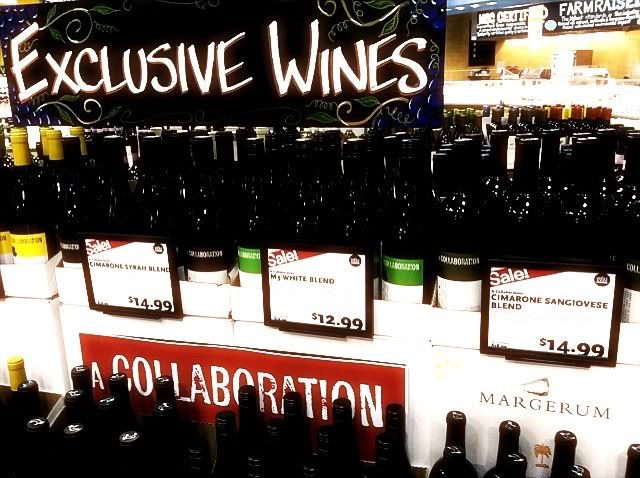
lovers in Southern California love their wine from Santa Barbara County. Syrah, Chardonnay, Pinot Noir and even Italian grape varieties from the Santa Barbara area are plentiful on wine shelves in Los Angeles, and the Santa Barbara wine country experience is just a short trip up the 101.
My eye was caught recently when I spied a collection of wines from Santa Barbara County at Whole Foods Markets in West Hollywood. Whole Foods is known for their "locally grown" stance in food, and now we see they have the same sort of regionalism in the wine department.
The wines go under the name "A Collaboration," and feature different wines of several different Santa Barbara County winemakers under the same label. These wines are made exclusively for Whole Foods Markets, and are only available in Whole Foods' Southern Pacific Region. They can't be ordered, either, as Whole Foods West Hollywood store only ships wine near Christmas. Southern California has these wines all to themselves.
Whole Foods throws a much-deserved spotlight on Santa Barbara County's climate, soil,terroir and winemaking talent in hopes of raising awareness of the wealth of wine located there among the everyday grocery shopper. To that end, the displays of "A Collaboration" wines are placed prominently in the stores with descriptive material - like large-format shelf talkers.
The winemakers involved in this collaboration are Doug Margerum of Margerum Wine andCimarone, Jim Clendenen of Au Bon Climat and Frank Ostini and Gray Hartley, the team behind the Hitching Post label.
Six blends are featured in the line, each with its own appeal, and all six should tempt any Southern California wine lover strolling the aisles of Whole Foods. They retail for between $15 and $17 a bottle. The chain describes the wines of "A Collaboration" this way:
Hitching Post, Central Coast Red Wine
"Frank Ostini and Gray Hartley of Hitching Post Winery created a 22 barrel selection that includes a blend of 73% Valdiguie and 27% Syrah. The selection was handcrafted for Whole Foods Market to feature the bold aromas of flowers, red fruits, dark berries, spice and a touch of bacon.
Hitching Post, Central Coast Rose Wine
Perfect for a warm, sunny, California afternoon, the 60% Valdiguie and 40% Pinot Noir handcrafted blend is a versatile dry rose that pairs well with a variety of foods.
Margerum Wine Company, M5 Red Blend
Owner and winemaker, Doug Margerum, crafts world-class wine, stressing individuality with connotations of nature. The first wine in the series is a five-grape, six-vineyard, 18-barrel selection blended from six Santa Barbara County vineyards and displays aromas of blackberry and blueberry backed by hints of violets, anise and leather.
Margerum Wine Company, M3 White Blend
A carefully crafted blend of 50% Sauvignon Blanc, 25% Riesling and 25% Old Vine Chenin Blanc is lively, bright, refreshing, clean and complex. Capturing the essence of spring in a bottle, the wine is perfect for outdoor dining and picnics.
Clendenen Family Vineyards Red Blend
With peak harvest season prolonged until fall, this wine benefits from a gradual ripening that allows the acidity to become softer and the flavor development to heighten; all made possible by the special relationship between the climate, site and grapes.
Au Bon Climat, Pinot Blanc
While the Santa Maria Valley is noted for its Chardonnay, Pinot Noir, and Syrah, the most distinctive grape in the valley is the Pinot Blanc—a more concentrated, rich and elegant varietal.
Cimarone Wines, Sangiovese Blend
Grown on the steep hillside of the magnificent Cimarone Wines estate, the Sangiovese has been a standout throughout Cimarone Wines’ rich history. This proprietary blend of Sangiovese, Syrah, Syrah Noir, Petit Verdot and Mablec is a wine that truly drinks well now but will reach its peak with bottle ages.
Cimarone Wines, Syrah Blend
Happy Canyon is one of the warmer Santa Barbara County wine regions for Syrah, producing wines that are rich and supple with long flavors. The dense, lean flavors of the other varietals, including Cabernet Franc, Petit Verdot and Malbec, perfectly complement the Syrah to make an unparalleled wine that showcases the future of the Cimarone brand.
Follow Randy Fuller on Twitter.

Wine Goes To The Movies
With NowAndZin.com and TrailersFromHell.com
If "Godzilla, King Of The Monsters" doesn't put you in the mood to drink some wine, I can't say I blame you. Sake, maybe. A special Jolt Cola/Espresso/Red Bull blend, definitely. But we don't think of wine as a beverage that puts us in the mood to destroy major cities - not good wine, anyway.
The theme of monsters - particularly Godzilla - runs fairly deep in wine culture, though. I picked up the scent of a Napa Valley wine called Cabzilla, which appeared briefly in 2002. It didn't take long for the people who own the rights to Godzilla to step in and trash that copyright infringement in good ol' Godzilla fashion, except without the firebreathing.
There's the TV ad for yellowtail Chardonnay, in which Godzilla stars. He sports a yellow tail, which is apparently where the connection ends. That's not close enough for Blood Of The Vines, and we're not recommending yellowtail Chardonnay to anybody, no matter whose tail is yellow.
I have no idea who makes Kyle's Homebrewed Godzilla Wine. Since wine is fermented, not brewed, this person may be a little confused. They also may have received a visit from Godzilla's lawyers after they took care of that messy business in Napa Valley.
There's a Godzilla Wine which is said to be on sale in Japan. It seems to be a little early to celebrate Godzilla's 60th anniversary; the wine bears the dates "1954 - 2014." It's sold by Koichi Kawakita, who was a special effects guy on a number of Godzilla movies, although not the 1956 classic. If you have a yen for it, it'll cost you 4,800 yen - about $53 - and you have to get it from Japan. Considering the sketchy information and difficulty in obtaining it, let's pass on this one, too.
The subtitles won't match, but we could look to Italy for a Godzilla pairing. Barolo is often referred to as the king of wines. That would seem fitting for the king of monsters. Giacomo Conterno Barolo Riserva Monfortino 1990 was said to have "mouth-searing levels of tannin" by wine critic Robert Parker, who also called the wine an "old style, monster Barolo." A bottle will run close to $400, though. If you're a little short until payday, let's opt for something more affordable - and with an actual connection to the movie.
Raymond Burr appeared in "Godzilla, King Of The Monsters," although in scenes added post-production. He got a chance to use his fine "mopping the sweaty brow" routine that he developed a couple of years earlier as Lars Thorwald in "Rear Window."
Burr had some land in Sonoma County's Dry Creek Valley long after his appearance in this film. Grapes were planted, wine was made and here's our recommendation: Raymond Burr Vineyards 2009 Estate Port, $48. It's produced from estate-grown Portuguese varieties Tinta Cao, Tinta Madeira and Touriga Nacional. It may not be described as a monster, but the wine does have a "long, complex finish," which is what Godzilla served up on Tokyo when he was brought out from the cellar. Also like Godzilla, this wine will age well for many years.
Godzilla on a budget:
1. Sebastiani "The Crusher" Clarksburg Petite Sirah - $13
2. Gemtree "Bloodstone" Shiraz-Viognier McLaren Vale South Australia - $14
3. Ballast Point Brewing Company "Sea Monster" Imperial Stout, 22 oz. - $11
Follow Randy Fuller on Twitter
Follow Trailers From Hell on Twitter.
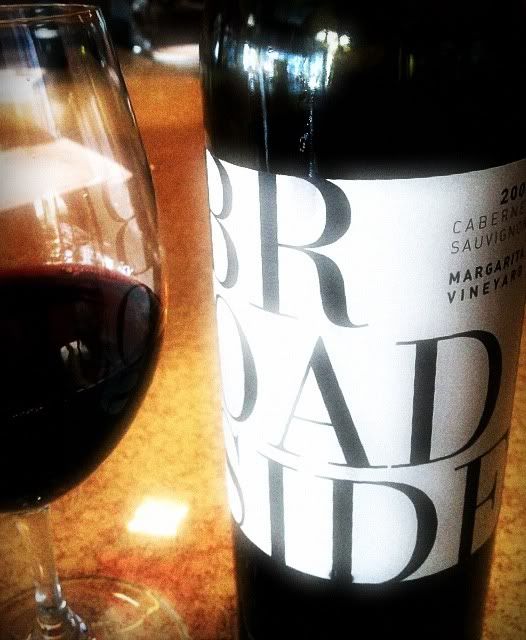
One of my favorite stops for "anytime wine tasting" in Southern California is the Santa Monica wine bar Pourtal. Stephen Abronson's cozy little space near the beach is filled with Enomatic taps where wine is dispensed by the ounce. You can have a taste of many or a glass of one or two. There are always themed Tasting Tours which rotate on a monthly basis. Pourtal's Wine Director Rachel Bryan makes excellent choices on the wines featured at any given time.
I was drawn to try the Broadside Cabernet Sauvignon when I noticed its grapes were taken from the Margarita Vineyard in the southern part of the Paso Robles AVA. I recently toured this vineyard - the Ancient Peaks estate vineyard - and was mightily impressed with the wines which Ancient Peaks crafted from that fruit. My hopes were high for the Broadside effort.
Broadside winemakers Chris Brockway and Brian Terrizzi attempt to let the grapes do the talking. The wine is made naturally, without yeast, bacteria or acid. Aging occurs in 100% French oak - 2% new - and the varietal makeup is 97% Cabernet Sauvignon and 3% Petite Verdot, also from Margarita Vineyard. It has an alcohol level of 14.1% abv. The Broadside Cab retails for $20 per bottle.
As expected, the wine looks dark and inky in the glass. The nose is a little hot at first, but that settles down quickly. Big aromas of dark fruit are laced with the minerals Margarita Vineyard is known for. On my tour of the vineyard, I saw firsthand the ancient oyster shells peeking up from the earth - a reminder of the land's former state as a seabed.
The taste is also enticingly dark and full of those wonderful minerals. Cassis and black cherry join with a vanilla spice component. There's a lot of wine here for $20.
Follow Randy Fuller on Twitter.
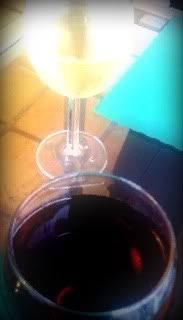
The wines on the list at Salades de Provence, my favorite French bistro in Los Angeles, are not fancy, but they always seem to pair to perfection with the wonderful food they make. I tried one recently which fit well with the food, but was a bit lackluster on its own.
The Sainte Chanelle Vin de Pays D’Oc Pinot Noir is the wine in question. It was smooth as silk, but dull as dishwater.
The Vin de Pays designation translates as “country wine,” and is a French wine production level below that of the A.O.C. and above the Vins de Table classification. Vins de Pays D’Oc hail from the Languedoc-Roussillon area in the south of France, near the Mediterranean.
The jury is mixed on this wine’s nose. Denise smells raisins and beef, while I find the nose quite challenged, with just a hint of roses. The taste is nice enough, if a bit plain. Earthy cherry dominates the palate and it pairs well with mushrooms and smoked salmon. I do not find its unobtrusive quality to be a virtue, though.
The Sainte Chanelle cost $9 per glass, and I’ve seen the ‘07 vintage for $9 a bottle at a local wine store, but I’ll take a pass on it the next time I see it offered.
The trip wasn't a total loss where wine was concerned, though. Denise enjoyed her Bordeaux Blanc quite a bit. I've written about it before.
Follow Randy Fuller on Twitter.
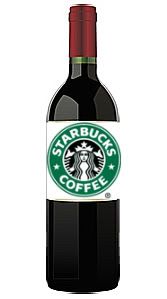
You may have heard that the national coffee chain, Starbucks, is experimenting with the addition of wine and beer to some of its locations. What does a Starbucks wine list look like? According to the Washington Wine Report, it looks about like what you'd expect from a broad-based national chain.
There were plenty of people wondering out loud whether Starbucks would roll out wine lists featuring local or regional wines. In a way, they have. But don't get too excited.
As I understand it, Seattle was the test market. I've seen notice of a Portland Starbucks, too, offering wine and beer.
There are seven wines on the lists I saw from both cities, four reds and 3 whites. The Pacific Northwest is represented by only three wines, and all come from beneath the Chateau Ste. Michelle umbrella.
Erath Pinot Noir, 14 Hands Hot To Trot red blend and Chateau Ste. Michelle's own Riesling qualify as regional wines, but they are from a very large producer and the selections are widely available.
Other choices on the menu include the Alamos Malbec from Argentina, the Canili Pinot Gris from Italy, the Martini California Cabernet and William Hill's Napa Valley Chardonnay. Decent wines, all, but nothing to make anyone jump and run down to Starbucks to get some before they run out.
I agree with the Washington Wine Report that the Starbucks wine list has a very corporate feel, not at all reflective of regional wines. Of course, I would have expected about as much. The company - if they follow through on rolling out the barrels nationwide - will watch the bottom line by purchasing safe wine choices in quantities great enough to afford volume discounts.
It's too bad, though. When Starbucks introduced their line of coffee drinks, they were giving us something we weren't getting anywhere else. With their wine list, it appears they are satisfied to give us something we can get everywhere else.
Follow Randy Fuller on Twitter.
The wine industry in Colorado began in 1890, when then-governor George Crawford planted 60 acres of grapes and other fruit along Rapid Creek, near Palisade. There was modest growth in grape growing and winemaking until you-know-what. Prohibition killed many states' wine industries. In Colorado, the bell tolled early, as the state passed its own Prohibition statute in 1916 - predating the national law by four years. All the grapevines were pulled up at that time in favor of fruit orchards. It wasn't until the late 1960s that grapes and wineries began reappearing in the state.
Norman Christianson was a geologist who made a career of mineral exploration before becoming a vintner. He founded Canyon Wind Cellars in 1991. A family-owned estate winery, Canyon Wind employs Napa winemaker Robert Pepi, who oversees the winemaking work of Jay Christianson.
Canyon Wind Cellars is located in the Grand Valley AVA, in Palisade, Colorado east of Grand Junction north of the Colorado River. The high altitude location offers their grapes hot days and cool nights in which to ripen in the sandstone soil.
The Christiansons are proud of their winery's greenness. In the vineyard, sustainable practices are observed: no herbicides are used and only organic pesticides when needed. A gravity flow system gets the wine to the barrel cellar using no electricity.
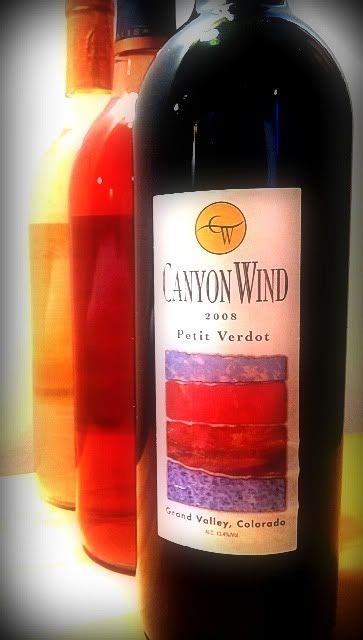 Canyon Wind Wines
Canyon Wind Wines
I received three wines to sample. Two of them are from Canyon Wind's 47-Ten series - a Pinot Grigio/Chardonnay blend and a Merlot rosé - and a Petit Verdot from their varietal line.
47-Ten White 2010
The name of the 47-Ten series refers to the altitude of the vineyards, 4,710 feet. That’s Rocky Mountain high. 60% of the wine is Pinot Grigio from the Cliffside Vineyard while the remaining 40% is Chardonnay from the Riverside Vineyard. At 13.6% abv, this wine does not bring the heat.
The nose shows lovely floral notes and honeydew on a somewhat earthy background. There are melons and peaches on the palate with a shading of yeasty minerality. It’s really quite a delicious white, with a zesty acidity. There’s plenty here to make it useful at the lunch or dinner table.
The mouthfeel is nice and full, and the nose and palate both show a bit of spiciness and vanilla. I was surprised to learn this is an unoaked effort - but the Pinot Grigio was aged sur lie in stainless steel for six months before being blended with the au natural Chardonnay. This explains the rich feel of this wine. (When the dead yeast cells - lees - fall to the bottom of the vat after fermentation, the wine is left in contact with the lees for a time to impart a richness and yeasty flavor.)
Put a chill on the 47-Ten White, and you have a perfect companion on the deck this summer.
47-Ten Rosé 2010
Another from Canyon Wind's 47-Ten line, this rosé is such a deep pink it’s almost red. Made from 100% Merlot, taken completely from Canyon Wind’s Riverside Vineyard, this wine is produced entirely in stainless steel.
The nose comes on like a fruit truck overturned. Fresh, ripe strawberries and cherries abound on the nose and palate, and it’s all fruit - no candy. It’s a wonderfully dry rosé with a nearly astounding level of acidity. I wouldn’t pair it with steak, not because I don’t think it could stand up it, but because I like a red wine with beef. I wouldn’t think twice about having this wine with a grilled pork chop. At 12.3% abv, it doesn’t hit so hard that you have to worry about the second glass.
Petit Verdot 2008
This blend of Petit Verdot and a two-percent splash of Cabernet Sauvignon is sourced entirely from Canyon Wind’s Riverside Vineyard. In the original planting for the vineyard in 1991, it was thought two blocks of Merlot from different nurseries were put in the ground. It turned out that one block was not Merlot, and it wasn’t until eleven years later - with the help of genetic fingerprinting - that the mystery block was determined to be Petit Verdot. A low-intervention vinification leads to 22 months in French and American oak.
Petit Verdot usually plays a supporting role in wines. Indeed, even this grape - during its time in the Twilight Zone - was used for blending. In this wine Petit Verdot gets to sit in the driver's seat and Cabernet Sauvignon has to ride shotgun.
The wine’s color is deep, dark red, but light does get through. On the nose, immediately upon pouring, there is a strong whiff of alcohol. That does not remain for long. In fact, the wine settles down very nicely in short order. The alcohol content is only 13.4% abv, so it was a bit of a surprise to find it so forceful at first. Other elements vie for my attention in much the same way. One whiff is full of amazing fruit - cassis and blueberry, jammy as can be - while another has campfire smoke and creosote on it. It’s like a fireworks show for the nose.
There’s a lovely greenness in the flavor profile and it’s unmistakable even amid all the intense fruit flavors. The wine has a medium-full mouthfeel and a firm tannic structure. It does not lack acidity and shows plenty of the earth in which the grapes were grown. Behind it all is a freshness that makes me think of a mountain stream - an unusual quality in a red wine, at least in my experience.
Our thanks go to Canyon Wind Cellars for contributing these wines and becoming an able representative for Wine Country Colorado.
Follow Randy Fuller on Twitter

Wine Goes To The Movies
with NowAndZin.com and TrailersFromHell.com
"Notorious," the 1946 classic from master of suspense Alfred Hitchcock, actually features a wine as a character in the movie. Hitch put a big clue to his mystery in a bottle of wine from Pommard, in France's Burgundy region.
Hitchcock was a wine connoisseur and really loved the northern California wine country. He loved it so much, he bought a ranch and vineyard near Scotts Valley during the filming of 1940's "Foreign Correspondent." That's why you see so many northern California locations in Hitchcock films - so he could be close to his digs between Santa Cruz and San Jose.
In "Notorious," when Cary Grant drops that bottle of 1934 Volnay Caillerets Bouchard, my heart skips a beat every time I see it. "Not the premier cru!" Fortunately, there's no great wine in the bottle, just a little pesky uranium ore which he neatly sweeps under the wine rack. That's where radioactive isotopes are always swept so they'll go unnoticed until someone brings in a Geiger counter.
No hazmat suits, not so much as a rubber glove for protection. Uranium is only weakly radioactive, which explains why Cary Grant didn't suffer any sort of disfigurement. If anything, he became even more suave and debonair afterward.
Ingrid Bergman doesn't fare so well in the movie. Oddly, she gets hers from a cup of coffee. Someone must have slipped some uranium into the sugar bowl.
You can find a recent vintage of Bouchard Volnay Caillerets for $50 to $60, but it appears that for the 1934 vintage you'll have to go to auction, so expect to spend a lot more. Louis Jadot has a Pommard which sells for around $40, and that appears to be the low end of the price range for that appellation.
If you need a really cheap date night, see the Blood Of The Vines pairing for "Arsenic & Old Lace."
Bargain Burgundy:
2008 Domaine Ballot-Millot & Fils Bourgogne Rouge - Leave the auction to Cary Grant. Here's some Pommard (with a little Meursault and Beaune thrown in) for about $20.
2007 Laboure Roi Bourgogne Blanc "Maximum" - A white blend of Meursault and Mâcon grapes - not far from Pommard - this Chardonnay is under $20.
Caves Bailly Lapierre Cremant de Bourgogne Brut - A sparkler from near Chablis, this will give you that Cary Grant feeling for about $15.
Blood Of The Vines also appears on the cool Trailers From Hell blog, From Hell It Came.
Follow Randy Fuller on Twitter.
Follow Trailers From Hell on Twitter.
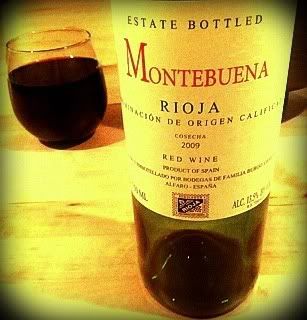
Wines from Spain get a lot of press lately for being great values. Reasonable price points and generally high quality have many wine lovers looking to regions like Rioja, Toro, Calatayud and Rias Baixas for great buys. I recently attended a tasting event in which a couple dozen tables full of Rioja wine were poured. All of them were of high quality, even the ones retailing for $10 or less. I had high hopes for the Montebuena Rioja wine which retailed for all of $12. I picked it up for eight bucks at a Los Angeles wine store sale.
Montebuena is produced by Bodegas Burgo Viejo of Alfaro, in the Rioja's Ebro Valley. It's a 100% Tempranillo wine with a 13.5% abv number.
Upon opening and pouring, I'm a little disappointed there there's a good deal of alcohol on the nose and palate. Even on the second - and third - night the bottle is open the alcohol is the dominant aroma.
Bright cherries come across rather uncomplicated otherwise, with just a hint of spice, but the bite is sharp - too sharp for my enjoyment. The fruit is bright, but with so few supporting elements the palate is on the thin side. There’s also an astringency to it that helps tip the scales on the side of unpleasantness.
Even as the tannic nature of the wine lessens a bit - after three days - the flavors don’t deepen or get richer, they simply go flat. Unfortunately, the astringency is still there. It's not such a shock that an inexpensive wine fails to impress, but it is a disappointment that such a great wine region is so poorly represented.
My guess is that pairing the Montebuena with the biggest, juiciest, fattest piece of beef you can find would improve its lot - at least the tannins would have something on which they could work. I sipped it solo, and I have enjoyed Two-Buck Chuck more - a lot more.
Follow Randy Fuller on Twitter.
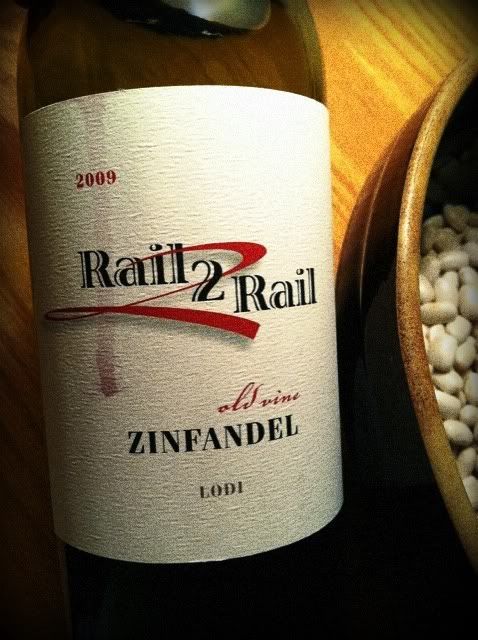
Buying a $10 wine can be a real gamble. There are plenty of good ones on the shelf, but there are some dogs, too. Zinfandels that thrill generally run a bit higher than a ten-spot, so my expectations were slim, hanging by the notion that an old vine Lodi Zin would save the day at that price point.
Rail2Rail Zinfandel is produced by the Laumann Family Estate Wines of Santa Cruz. This is one of three labels produced by Eric Laumann, the other two being Cambiata and Ludwig.
I have tried Cambiata's Albarino before, and liked it. I also like the fact that Laumann trades in grapes you don't see very often in California, like Tannat and Dornfelder. The '08 vintage of the Zin won awards at a couple of competitions, so I was looking forward to this Zinfandel.
The name, by the way, is taken from a surfing term which describes a "full commitment S-turn." A rail-to-rail turn is a showy move that sprays water everywhere. Along that line, the label promises a big wine, but one which keeps the tannins in check and balanced.
The wine does come on big, with a 14.5% abv number. Most of that shows up on the nose when the bottle is first opened. The smell of alcohol nearly knocked me over on the first whiff. Big , bright cherry and blueberry aromas do manage to make their way through.
Even on the third night the bottle was open it was alcohol-heavy. It also took on more of a candy-like appearance on the palate which I didn’t find too enjoyable. A brambly character that appeared saved it from despair, but just by a bit. It's a far cry from unpalatable, but I kept wishing more had been delivered.
Rail2Rail is a $10 Zinfandel that, unfortunately, drinks like one.
Follow Randy Fuller on Twitter.

Do you worry about whether or not the wine you drink measures up to European standards? Wine Spectator contributing editor Matt Kramer wondered that recently as he was sitting in a bar in Salzburg sipping a Zweigelt. Aah, the life of a wine writer.
Kramer, in a Wine Spectator article, points out that in the past three decades great advancements have been made in winemaking the world over. European wines were once thought unmistakably superior in quality to wines from Australia, New Zealand, Argentina, Chile and, yes, America.
In the article, Kramer goes on to suggest a scheme for judging New World wines against European ones. Variety, originality, technical prowess, finesse and vocabulary are the criteria he came up with for measuring wines from different regions head to head.
It's not a bad idea - sports fans have always relied on a list of criteria to rate a team from one era against one from another. Such comparisons help pass the time while drinking at the bar, but they rarely produce definitive results.
Why should it matter? What is to be gained by trying to pick a winner between the 1927 Yankees and the 1976 Reds, except the burnishment of fan pride? Actors often complain about the competition they are thrust into by the Academy Awards. Why should there have to be a winner if the nominees all did a great job of acting?
Are European wines better than California wines? The ultimate test is your own palate. There's plenty of room in the big ol' world for great wine from everywhere. Others have said it before me, but it bears repeating: drink what you like. Your favorite wine is the best wine in the world, and nobody can argue that away from you.
Follow Randy Fuller on Twitter.







 Elk Creek Vineyard's Estate Cabernet Franc 2008 is the second vintage of this wine from Elk Creek. Cab Franc is considered by the University of Kentucky to be
Elk Creek Vineyard's Estate Cabernet Franc 2008 is the second vintage of this wine from Elk Creek. Cab Franc is considered by the University of Kentucky to be 

 The Dracula Pinot Noir 2007 is made from Santa Maria grapes - picked before sunrise, of course. The wine spent 18 months in French oak. It has a big, rich nose and big, rich flavors to match. Cherry and raspberry notes dominate in properly dark fashion.
The Dracula Pinot Noir 2007 is made from Santa Maria grapes - picked before sunrise, of course. The wine spent 18 months in French oak. It has a big, rich nose and big, rich flavors to match. Cherry and raspberry notes dominate in properly dark fashion.







 Canyon Wind Wines
Canyon Wind Wines


